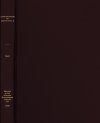Identification Key Monograph
By: Ian D Gauld(Author), Sondra Ward(Contributor), Victor Mallet(Contributor)
453 pages, 435 b/w photos and line drawings, 14 tables
![The Ichneumonidae of Costa Rica Volume 3 The Ichneumonidae of Costa Rica Volume 3]()
Click to have a closer look
About this book
Related titles
About this book
Language: English with bilingual summary in English and Spanish
Intensive biological inventory has revealed the presence in Costa Rica of 198 species of the ichneumonid subfamilies Brachycyrtinae, Cremastinae, Labeninae and Oxytorinae. Illustrated keys are provided here to enable them to be identified by the non-specialist. Of this fauna, 161 species are described as new, two are thought to be new, but have not been named pending discovery of more material, and the remainder, which have previously been described, are redescribed in a standardised format. An appendix provides a supplement to the treatment of the Anomaloninae given in Volume 2 of this series (Memoirs of the American Entomological Institute, Volume 57).
In this volume, an additional new species, Barylypa broweri, is described. Where known, details are presented about the geographical distribution, seasonal abundance and recorded hosts of all the various taxa. The subfamily Brachycyrtinae is restricted to include only the genus Brachycyrtus and Australian taxa previously placed in the group are transferred to the Pedunculinae. The characters distinguishing the two subfamilies are given. The monobasic subfamily Oxytorinae (Oxytorus) is here recorded for the first time from the Neotropics, and two genera are newly recorded from the tropical America: the Holarctic and Australian cremastine genus Dimophora Foerster and the Holarctic and Old World anomalonine genus Barylypa Foerster. The South American genus Hanauella Enderlein is removed from synonymy with Eiphosoma and treated as a distinct genus.
At the species-level nine new synonymies are proposed: Brachycyrtus crossi Kreibohm de la Vega and B. crossi Blanchard under B. pretiosus Cushman (syn. n.); Eiphosoma parana Morley under E. nigrum (Szépligeti) (syn. n.); Eiphosoma texana Cresson, E. variegatum Brèthes and E. lacteum Cockerell under E. dentator (Fabricius) (syn. n.); Eiphosoma swartzi Cockerell and E. insulare Viereck under E. nigrovittatum Cresson (syn. n.); Labena testacea Szépligeti under L. gloriosa Cresson (syn. n.). Xiphosomella tabascensis Morley is transferred to the genus Eutanygaster, and Eiphosoma mexicana Cresson is removed from synonymy with Eiphosoma nigrolineata (Brullé) and re-instated as a distinct species. A new name, Xiphosomella claudei, is proposed for Eiphosoma parana var. nulla Morley, a species previously erroneously included as a synonym of Eiphosoma batatae Cushman. The species widely called Eiphosoma vitticolle Cresson in the agro-entomological literature should be called E. laphygmae Costa Lima, as the true vitticolle seems to be a different species. Full nomenclatural details are listed in Appendix 2.
Customer Reviews
Identification Key Monograph
By: Ian D Gauld(Author), Sondra Ward(Contributor), Victor Mallet(Contributor)
453 pages, 435 b/w photos and line drawings, 14 tables

































